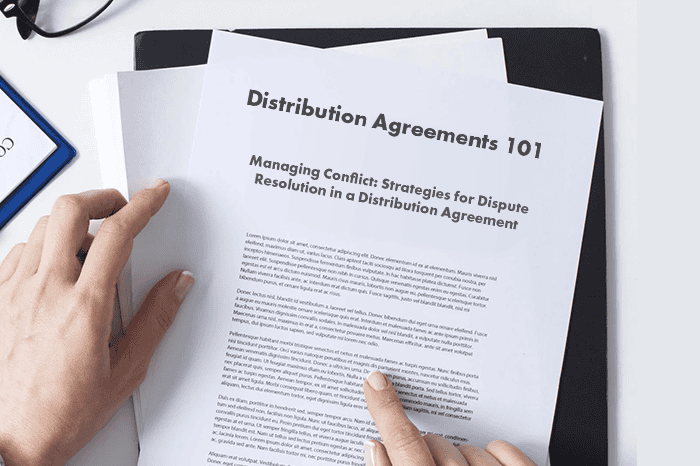Table of Contents

A distribution agreement is a legally binding contract between a distributor and a supplier. Appointing a distributor to sell their products allows the supplying company to focus on evolving their products. A distribution agreement entails the pricing terms, the identification of parties in the agreement, clauses concerning the protection of a party’s interests, delivery details, and the clauses on termination.
Many times, a distribution agreement-based relationship observes conflict of interest arising from pricing negotiations, maintenance of standards, breach of confidentiality, errors in communication, failure to perform and fluctuating trends in the market. Since the occurrence of a conflict is highly probable, parties should seek to establish structures that allow them to reach a mutually beneficial solution. In doing so, they can maintain a long-term relationship and augment the chances of the success of their respective businesses. Parties can also seek legal counsel to identify, approximate and resolve issues.
Having a well-drafted distribution agreement assists the parties in identifying their roles and responsibilities. Therefore, suppliers and distributors are recommended to seek agreement templates that can be tailored to their unique needs.
Causes of Conflict in a distributor-supplier Relationship
In a distribution agreement, a distributor and supplier may disagree for a variety of reasons. Pricing is one of the most frequent points of contention between distributors and suppliers. Suppliers may believe they are not making enough money from the sales, while distributors may feel they are not receiving the greatest price for the goods they are selling. Suppliers and distributors could have various strategies for promoting the goods they are offering. Disagreements concerning branding, promotions, and advertising are examples of this.
Misunderstandings and disagreements can result from poor communication between distributors and suppliers. Problems with order processing, delivery schedules, and product availability may fall under this category. Conflicts may occur if one side violates the conditions of a territorial agreement between a distributor and a supplier or if the borders of the territory are unclear.
A distributor may refuse to sell products or seek payment from the supplier if they believe the quality of the goods they are selling is subpar. Conflicts can occur over things like market share and product differentiation if a distributor and supplier are in direct competition with one another in the same market.
Conflicts between a distributor and supplier can also result from disagreements about the terms of the distribution agreement, such as exclusivity provisions or termination rights. To maintain a successful distribution relationship, both parties must communicate, work toward mutual goals, and resolve conflicts in a timely and respectful manner.
Dispute resolution and conflict management
Any business relationship, including distribution agreements, can lead to conflict. In a distribution agreement, there are numerous strategies for managing conflict and resolving disputes. The first step in conflict resolution and management is to avoid it. Both parties must establish open lines of communication. Ensure that all parties involved in the distribution agreement have open lines of communication. This includes establishing protocols for regular meetings or check-ins and identifying key points of contact. In the distribution agreement, the companies should also clearly define roles and responsibilities. They should make certain that everyone is aware of their roles and responsibilities under the distribution agreement. This can help to avoid conflicts caused by misunderstandings or misaligned expectations.
The expectations and goals of each party should be set clearly. During the process of negotiation, it is helpful for parties to communicate their ambitions and intentions of entering the agreement. Establish clear expectations and goals for the distribution agreement. This includes- but is not limited to outlining sales targets, delivery schedules, and other important metrics. Having a shared understanding of what success looks like can help prevent disputes from arising in the first place.
In most cases, parties can anticipate potential conflicts. Addressing its possibility before it occurs can be a significant step in dispute resolution. This also assists parties in developing a dispute resolution process. They may lay out a clear procedure for resolving any disagreements that may arise during the distribution agreement. This can include appointing a neutral third party to mediate disputes, establishing resolution timelines, and outlining consequences for noncompliance. Mediation is regarded as an effective method of resolving disputes without resorting to the courts.
Seeking legal counsel is part of exercising caution to avoid large liabilities in the event of future conflicts. Each state’s legal provisions differ, and if you are conducting an international or oversea exchange of goods, it is best to seek assistance from individuals who are familiar with the legal and financial trends in those countries. As a result, it is always advisable to seek legal counsel before entering into a distribution agreement. A lawyer can help you understand your rights and obligations, as well as identify potential future issues.
Both the supplier and the distributor benefit from a long-term exchange relationship. Finding a trustworthy party can be a difficult task. As a result, maintaining the relationship through simple conflicts is sometimes the best strategy. As a result, the parties should concentrate on finding mutually beneficial solutions. When disagreements arise, focusing on finding mutually beneficial solutions may be more advantageous than attempting to win the argument. This can help to preserve the parties’ relationship and ensure the distribution agreement’s long-term success.
Conclusion
Pricing, communication issues, product quality, competition, and territory issues can all be sources of contention between the supplier and the distributor. Disputes arise frequently in similar transactions, and addressing potential issues without jeopardizing the relationship is critical in a successful supplier-dealer relationship. A company can take several steps to avoid conflict. They can fortify the distributor agreement and devise a conflict resolution strategy.
Raveena Rani
Raveena is a seasoned International IP Counsel with a unique blend of engineering and legal acumen, specializing in Intellectual Property, Technology Law, and Corporate Transactions. She has extensive experience drafting and negotiating NDAs, commercial agreements, and legal documents in the areas of M&A, SaaS, and AI. Her global perspective is complemented by hands-on internships, corporate counsel roles, and mentoring initiatives. She thrives at the intersection of law, business, and technology.






